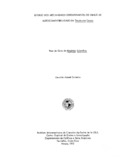Mostrar el registro sencillo del ítem
Estudo dos mecanismos determinantes de graus de autocompatibilidade em Theobroma cacao
| dc.contributor.author | Carletto, Gerardo A. | |
| dc.date.accessioned | 2014-10-17T15:15:24Z | |
| dc.date.available | 2014-10-17T15:15:24Z | |
| dc.date.issued | 1972-03 | es_ES |
| dc.identifier | 319932 | es_ES |
| dc.identifier.uri | https://repositorio.catie.ac.cr/handle/11554/1895 | |
| dc.description | Tesis (Mag. Sc.) -- IICA, San José (Costa Rica), 1972 | es_ES |
| dc.description.abstract | The present study was carried out in order to prove Coral's proposal of the existence of degrees of selfcompatibility in cocoa, and at the same time to determine whether this phenomenon is regulated by the genetic mechanism of heredity or due to chromosomal abnormalities. In order to study the degrees of selfcompatibility, the studies of Knight and Rogers on the setting and abscission of the flowers and that of Cope on fusion and non-fusion of the ovules, were used as the base. In addition, a cytological study was carried out on the chromosome pairing in the formation of pollen and its normality in order to know its behavior in relation with the proposal. The results of the settings and abscissions were obtained through a diallelic cross between clones ICS-1, UF-667 and UF-29. The statistical analysis through the Chi exponent 2 test showed that the segregations in selfing adjusted to Coral's proposal, however when the results of the reciprocal crossings were observed, no adjustment to the theoretical expectation was found. Besides this, the results of the majority of the combinations also adjusted to the other segregations. It was also observed that the size of the sample was small and could be influencing the results. According to the tendencies observed for the Chi exponent 2 values, no evidence was found for Coral's proposal on the degrees of selfcompatibility. All the clones studied were selfcompatible and this condition was better explained by Knight and Roger's method than by Cope's. When the data on fusion and non-fusion of the ovules was analyzed in order to prove Cope's theory, it was found out that all three clones did not adjust to the theoretical expectation of 100 percent fusion and that they did adjust to the 3:1 proportion, that is, 25 percent of the ovules did not pair, thus not offering conditions to explain the degrees of selfcompatibility. The study on chromosomal pairing in the formation of pollen grains was made in metaphase I and that data revels that there exists no uniformity in the pairing not only in the selfcompatible clones but also in their hybrids with an incompatible parent. No relation was found between the abnormal pairing of chromossomes with the degrees of selfcompatibility and the normality of polen grains. | es_ES |
| dc.language.iso | pt | es_ES |
| dc.publisher | IICA, San José (Costa Rica) | es_ES |
| dc.subject | CROMOSOMAS | |
| dc.subject | THEOBROMA | |
| dc.subject | CACAO | |
| dc.subject | HEREDABILIDAD | |
| dc.subject | TRASTORNOS GENETICOS | |
| dc.title | Estudo dos mecanismos determinantes de graus de autocompatibilidade em Theobroma cacao | es_ES |
| dc.type | Tesis de maestría | es_ES |
| dcterms.rights | acceso abierto | es_Es |
Ficheros en el ítem
Este ítem aparece en la(s) siguiente(s) colección(ones)
-
Tesis [3078]


